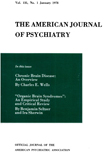The psychedelic model of schizophrenia: the case of N,N- dimethyltryptamine
Abstract
The authors review the research on N,N-dimethyltryptamine (DMT) as a possible "schizotoxin." DMT produces psychedelic effects when administered to normal subjects, the means are present to synthesize it in man, it has occasionally been found in man, and tolerance to its behavioral effects is incomplete. However, DMT concentrations have not been proven to differ significantly in schizophrenics and normal controls. Also, in vivo synthesis of DMT has not been convincingly demonstrated, and the psychological changes it produces do not closely mimic the symptoms of schizophrenia. The authors conclude that more data are necessary before the validity of this theory can be determined.
Access content
To read the fulltext, please use one of the options below to sign in or purchase access.- Personal login
- Institutional Login
- Sign in via OpenAthens
- Register for access
-
Please login/register if you wish to pair your device and check access availability.
Not a subscriber?
PsychiatryOnline subscription options offer access to the DSM-5 library, books, journals, CME, and patient resources. This all-in-one virtual library provides psychiatrists and mental health professionals with key resources for diagnosis, treatment, research, and professional development.
Need more help? PsychiatryOnline Customer Service may be reached by emailing [email protected] or by calling 800-368-5777 (in the U.S.) or 703-907-7322 (outside the U.S.).



